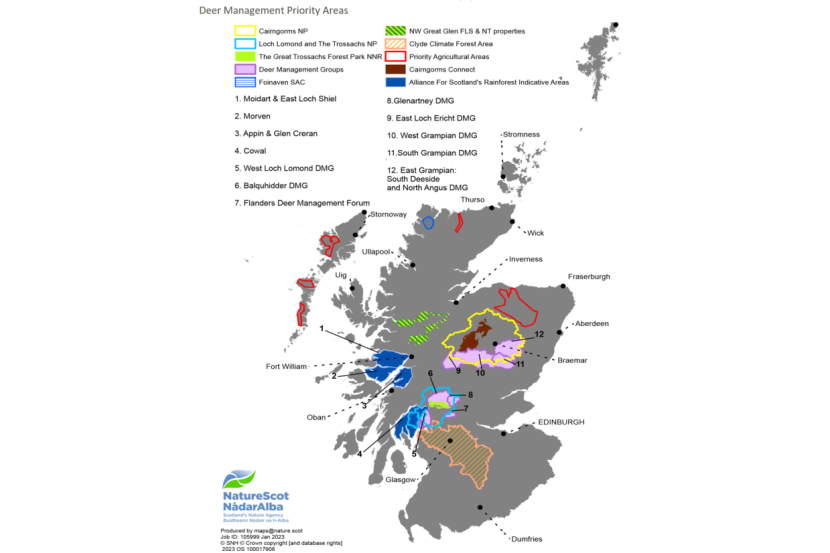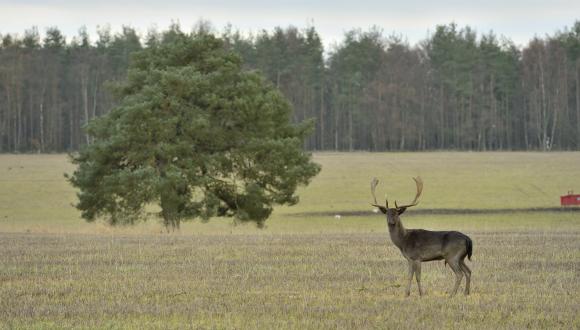Recognising the important role deer management plays in helping address the climate and biodiversity crises, the Operational Delivery Workstream of the Deer Management Strategic Board has identified a series of ‘Deer Management Priority Areas’. For these areas, action plans for delivering more effective sustainable deer management are being developed, and delivery against these plans will be monitored.
Identifying Deer Management Priority Areas
The Operational Delivery Workstream comprises several agencies which have been tasked by the Scottish Government with developing and overseeing delivery of regional deer management plans. These plans focus on deer management actions in particular locations where landscape scale opportunities exist for reducing deer impacts.
The Deer Management Priority Areas are based on:
- Areas where landscape-scale impact reduction and restoration was underway and delivery opportunities had been identified.
- Reducing impacts in the uplands by focussing on Deer Management Groups with the highest red deer densities (<15/km2)
- Public land ownership as areas of opportunity to demonstrate best practice.
- Regulatory priorities
- Forestry Grant Scheme delivery and leverage associated with incentive and contractual obligations.
- Impacts on the National Forest Estate where collaborative approaches could be better utilised
- Protecting peatland restoration (Peatland Action sites)
- Priority peatland habitat impacts
- Public safety – priority risk areas as identified by the Deer Vehicle Collisions project and local intelligence
- Agricultural impacts from deer linked with the expansion of the red deer range in addition to Fallow and Sika range expansion.
- Areas in the lowlands where opportunities for collaborative working are more limited based on the fragmented landscape.
What does a ‘Deer Management Priority Area’ mean?
Within Deer Management Priority Areas, the aim is to deliver a cohesive and dynamic ‘on the ground’ approach to deer management, with all partners maintaining focus on opportunities for delivering at a landscape scale. This approach reflects the urgency associated with the climate and biodiversity crises, in addition to addressing other impacts such as damage to agricultural and safeguarding public safety. The Operational Delivery Workstream will ensure consistency of approach, consider and resolve barriers to delivery and keep priorities under review.
Action plans
The Action Plans will include:
- The lead organisation and detail on the delivery partners needed to successfully deliver on the ground action.
- Scale and extent of the priority area, reflecting the issues and opportunities of the area (e.g. the scale required for a collaborative approach)
- The objectives and outputs associated with the priority area.
- The broad and specific actions required to deliver the outputs.
- Models and approaches required (e.g. species of deer and wider herbivore pressures)
- Issues and barriers to effective progress will be identified e.g. including infrastructure and skills uplift to ensure delivery on the ground
Monitoring Delivery
Delivery of the Priority Area Action Plans will be monitored and plans will be updated in response to new data and information as it becomes available.
Reviewing the priorities
The Deer Management Priority Areas Map summarises indicative areas; the detailed boundaries will be refined through the development of localised delivery plans. As priorities evolve, particularity linked with regulatory action, flexibility will retained so that resources can be directed quickly to where they are most needed.

View a larger image of the map.
Map of Scotland with Deer Management Priority Areas outlined and twelve associated Deer Management Groups/ Forums identified.
The Deer Management Priority Areas are:
- Cairngorms National Park
- Loch Lomond and the Trossachs National Park
- The Great Trossachs Forest Park National Nature Reserve
- Foinaven Special Area of Conservation
- North West Great Glen Forestry and Land Scotland and National Trust for Scotland properties.
- Clyde Climate Forest Area
- Priority Agricultural Areas
- Cairngorms Connect
- Alliance for Scotland’s Rainforest Indicative Areas.
The associated Deer Management Groups (DMG)/ Forums (DMF) are:
1. Moidart and East Loch Shiel DMGs
2. Morven DMG
3. Appin and Glen Creran DMG
4. Cowal DMG
5. West Loch Lomond DMG
6. Balquidder DMG
7. Flanders DMF
8. Glenartney DMG
9. East Loch Ericht DMG
10. West Grampian DMG
11. South Grampian DMG
12. East Grampian: South Deeside and North Angus DMG






